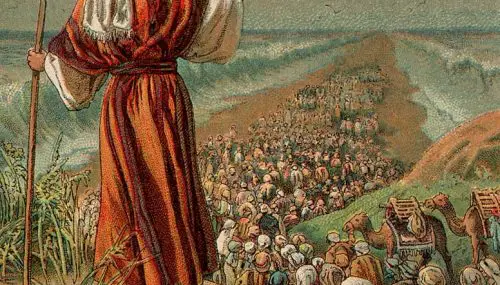There are two big takeaways from the continuing upheaval and the events of the past few weeks:
- Hashem is running the world. In an instant and unexpectedly, our lives can dramatically change. While that change may be uncomfortable, we can choose to remember the One Who is Pulling all the Strings and work to focus on all the good and light that surrounds us constantly. Or, we can forget that there is a Ribbono Shel Olam. We can let ourselves get caught up in all the difficulty and lose ourselves in a sea of anger, depression, anxiety and fear.
- Either way, Hashem is trying to speak to us…
Pesach is a chag of emuna. It’s a time to get rid of all of the clutter in their lives, to clean up and organize, to let go and get rid of the things that are distracting us and taking up way more space than they should.
When we let go of these things that’s when we have the space and peace of mind to remember the One Who brought us to our current situation in life. We reconnect to why we are here and where we are trying to go. We can see more clearly the spiritual and physical obstacles in our way and yearn to reach a better place.
All of this reflection and yearning is really the key to emuna, and when we reach such a state of mind that’s when miracles happen.
On Leaving Egypt… Our Thoughts Create a Reality
On Sedar night, each of us is obligated to see ourselves as if we personally left Egypt:
In every generation a person must see himself as though he personally had gone out of Egypt, as it is said: “And you shall tell your son in that day, saying: ‘It is because of what the Lord did for me when I came forth out of Egypt.’
בְּכָל־דּוֹר וָדוֹר חַיָּב אָדָם לִרְאוֹת אֶת־עַצְמוֹ כְּאִלּוּ הוּא יָצָא מִמִּצְרַיִם,
שֶׁנֶּאֱמַר: וְהִגַּדְתָּ לְבִנְךָ בַּיּוֹם הַהוּא לֵאמֹר, בַּעֲבוּר זֶה עָשָׂה ה‘ לִי בְּצֵאתִי מִמִּצְרַיִם
There are many interpretations of what it means to “see ourselves as if we left Egypt.” One well-known commentary is that each of us must try to imagine what it was like to have been a slave in Egypt and then look at ourselves as though we were personally redeemed. Another is that each person should consider the exodus from Egypt as a personal miracle, done for his or her sake, since the redemption of our forefathers means that we ourselves do not have to be slaves today.
But there is another way to understand this obligation…
According to the Chazal, the Egyptian exile is the root of all the future exiles that the Jewish people, as nation, have experienced. (Bereshis Rabbah 16:4)
But, it sits at the root of our personal exile, as well.
The Baal HaTanya explains that the main aspect of galus is galus hanefesh (exile of the soul)– when a Jew’s unique inner divine spark is in confinement and hidden from him. Without a connection to our Divine essence and to Hashem, we are no different to the animals that roam around the world.
Rebbe Nachman of Breslov, further explains that the concept of “Mitzrayim” (מִצְרָיִם) is a state of being where you can not see Divine Providence in your life. It is really “m’tzarim,” a narrow place of constriction and distress, darkness and slavery. It’s a place where the forces of nature seem so real and overpowering that you can witness wondrous miracles, but not be moved by them. You can see the sea split before your very eyes and attribute it all to nature: “Well, there must have been a really strong wind that day.”
Perhaps the biggest and most detrimental illusion of all is that we feel that we are trapped, that the gates of teshuva are closed to us and that we will never be able to break free from our personal shortcomings, imperfections and blocks.
Each one of us is brought into the world to refine and perfect ourselves and ultimately bring the world to completion by revealing Hashem, Who is hidden, within it.
In the upper realms there is an image of who we could be and our goal is to get ourselves “down here” to match the image “up there.”
Such was the case with Avraham Avinu. Just as Avraham was about to slaughter his son Yitzchak at the Akeida, an Angel called to him, “Avraham, Avraham,” before telling him to follow through with the act.
Why did the Angel say his name twice?
The Midrash explains that each person has two images: one of this world and another heavenly image. The image of this world is what we make of ourselves. It reflects how successful we’ve been to work on our imperfections and fulfill our spiritual tafkid (role) in the world. Our heavenly image represents what we could become if we reach our complete potential. After he passed the last of his ten trials, Avraham finally reached his complete potential and consequently, his two images became identical.
What would we look like if all the internal blocks were lifted… if all the distressful emotions disappeared… if we used our talents, skills, personality and experiences in life to serve Hashem and bring others closer to Him? What would it look like to be fully at peace with our spouses, children, parents, friends, neighbors, and peers? Who could we and those connected to us become?
On the sedar night, we should try to see ourselves as if we’ve already left our personal Mitzrayim and believe with all of our might that we can get there.
In fact, another translation of חַיָּב אָדָם לִרְאוֹת אֶת־עַצְמוֹ, is that a person is obligated to see his “essence:” The word atzmo, usually translated as “himself,” can also be translated as “his essence.” This is an allusion to the inner Divine spark found in each of us. We must seek to strengthen this holy spark no matter how low a state we reaches. (Yismach Yisrael Haggadah p107a)
Pesach is a chag of emuna… we can choose to believe that change is truly possible… that Hashem listens to our tefillas… that He will give us the strength… clarity… and determination to do teshuva. We can choose to believe in ourselves and our inherent worth. We can choose to believe that we can get out of the darkest, most stubborn parts of ourselves even if we are very far from that place at the moment– and we can choose to to believe that our present circumstances in life are only there in order to help us down that path.
Emuna on sedar night can propel us further than it can at other times of the year. On the night of the sedar, particularly at chatzos, Hashem “passes over” and looks inside our internal “house” to see where we are holding… where do we really want to go? Who do we really want to be?
In the Sephardic text of the Hagaddah, the wording of the obligation is to “show to oneself” (l’harot et atmzo) as having come forth from Egypt. With the addition of a single Hebrew letter, this version changes the obligation from one of personal contemplation to one that affects the way in which we act in the world. In other words, we can act as if our personal yeshua has already happened.
According to the Baal Shem Tov, a person is where his or her thoughts are. If our thoughts during Sedar night are where we could be personally, where we want to be, then in the spiritual realms it as if we are already there.
According to the gemara, three times a year the world is judged: on Pesach, Shavuos, and Sukkos… where do you want to be at those moments?
Sedar night is called a night of anticipation– a night when Hashem waits with anticipation to free us (Rashi Shemos 12:42) from our inner exile. We just have to meet Him there…

